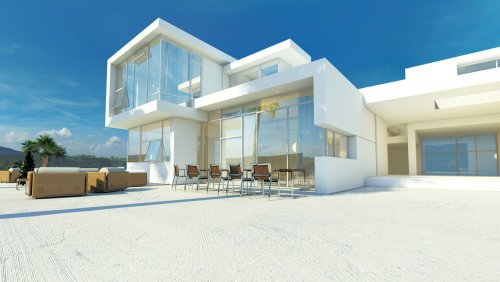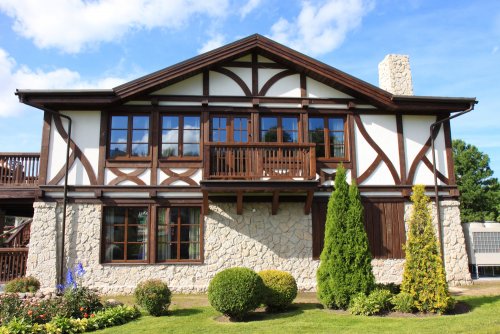Picking Out the Material for Your Home Exterior

We want our home to look nice on the outside and aesthetics and resistance have to go hand-in-hand. So in today’s post, we have some guidelines to share with you about how to choose the material for your home exterior.
Weather conditions, time and a general lack of care can really run down a home exterior appearance over time.
How a building looks shouldn’t only be aesthetically pleasing, but they should also have the appropriate infrastructure to withstand any sort of outdoor adversary.
Let’s take a look at some examples materials and helpful advice for designing a home exterior.
Stone
This is a tough, robust material that’s also visually appealing. Stone guarantees us strong walls that can keep a home perfectly insulated.
You can use stone in different ways. One example is masonry along with some mortar, which offers a rustic design with a distinct personality without sacrificing the ability to conserve heat indoors.
Another example is a design with carved stone blocks that are stacked symmetrically, alternating longer and shorter pieces. Each block is neatly organized. Like the former example, this is a safe, elegant and practical option.
Slate is another stone that’s strong yet decorative thanks to its color and texture. It’s usually a popular material in mountain towns; some great examples are the Spanish towns near the Leon region. Slate works best for roofs.
If you’re looking for a more traditional option, brick can create that rustic ambiance that, to some degree, can resemble masonry, especially if you use weathered or darker colored bricks.
There are plenty of construction materials that can create different home exteriors. While you’ll be able to find numerous possibilities for your home, you have to think about the kind of home exterior that you want.
Concrete
Another good material is exposed concrete.
Why use concrete for your exteriors? For strictly aesthetic reasons. Naked concrete doesn’t try to adorn walls nor look for special lines or colors that create a certain style.
Instead, it creates an urban, contemporary and minimalist look. In other words, the construction is very elemental, following a rationalist design that’s very similar to the Le Corbusier style. The result is a home that transmits smooth, simple straight lines and basic shapes. At the same time, concrete is robust and consistent while keeping the home safe from any kind of exterior risk.

Big windows
You can open your home to the outdoors though big windows or large sliding doors. These kinds of windows will help establish an open connection with the world. Compared to the other materials, this material isn’t as closed-off.
But of course, your home exterior can’t be made only of glass windows. While it may work for big office buildings or skyscrapers, homes shouldn’t be solely made with glass.
The base structure should be sturdy, made with something like cement rather than glass. Glass lets more light in while reducing architectural mass; as a result, homes can have a lighter structure.
From an aesthetic standpoint, glass creates an original style that’s a bit different from the norm. Additionally, glass homes can help you save a lot on electricity thanks to letting in natural light most of the day.

Mixed style
Why not use various materials together? Mixing materials can be another solution for choosing the material of your home exterior. You don’t have to limit yourself when working out a design.
Below, we have a nice list of some combinations that work perfectly together:
- Stone and mortar.
- Brick and mortar.
- Stone and glass.
- Concrete and glass.
- Metal and concrete.
- Wood and stone.
There are undoubtedly many other possibilities to fit any taste. However, avoid randomly pairing materials together. Instead, think about the colors and harmony between the materials carefully.
We also have to mention a material that could also play an important role in home exteriors: metal.
You should use metal alongside another material; so avoid covering your entire home exterior with it. Metal should only be on specific areas of your home. You have to use it sparingly, making sure that it’s seen but not stealing the show.

Metal shouldn’t be symmetrical, but rather, unique. You should use it in a corner or covering up a section of a wall. A great thing about metal is that you can mold and work it however you like.
Home exterior conclusion
The variety that there is for home exteriors is plentiful. You can really achieve visual success by following our advice.
Design isn’t just limited to indoor settings; a home’s exterior can start with a preview of what’s inside. So, choose your materials wisely.
We want our home to look nice on the outside and aesthetics and resistance have to go hand-in-hand. So in today’s post, we have some guidelines to share with you about how to choose the material for your home exterior.
Weather conditions, time and a general lack of care can really run down a home exterior appearance over time.
How a building looks shouldn’t only be aesthetically pleasing, but they should also have the appropriate infrastructure to withstand any sort of outdoor adversary.
Let’s take a look at some examples materials and helpful advice for designing a home exterior.
Stone
This is a tough, robust material that’s also visually appealing. Stone guarantees us strong walls that can keep a home perfectly insulated.
You can use stone in different ways. One example is masonry along with some mortar, which offers a rustic design with a distinct personality without sacrificing the ability to conserve heat indoors.
Another example is a design with carved stone blocks that are stacked symmetrically, alternating longer and shorter pieces. Each block is neatly organized. Like the former example, this is a safe, elegant and practical option.
Slate is another stone that’s strong yet decorative thanks to its color and texture. It’s usually a popular material in mountain towns; some great examples are the Spanish towns near the Leon region. Slate works best for roofs.
If you’re looking for a more traditional option, brick can create that rustic ambiance that, to some degree, can resemble masonry, especially if you use weathered or darker colored bricks.
There are plenty of construction materials that can create different home exteriors. While you’ll be able to find numerous possibilities for your home, you have to think about the kind of home exterior that you want.
Concrete
Another good material is exposed concrete.
Why use concrete for your exteriors? For strictly aesthetic reasons. Naked concrete doesn’t try to adorn walls nor look for special lines or colors that create a certain style.
Instead, it creates an urban, contemporary and minimalist look. In other words, the construction is very elemental, following a rationalist design that’s very similar to the Le Corbusier style. The result is a home that transmits smooth, simple straight lines and basic shapes. At the same time, concrete is robust and consistent while keeping the home safe from any kind of exterior risk.

Big windows
You can open your home to the outdoors though big windows or large sliding doors. These kinds of windows will help establish an open connection with the world. Compared to the other materials, this material isn’t as closed-off.
But of course, your home exterior can’t be made only of glass windows. While it may work for big office buildings or skyscrapers, homes shouldn’t be solely made with glass.
The base structure should be sturdy, made with something like cement rather than glass. Glass lets more light in while reducing architectural mass; as a result, homes can have a lighter structure.
From an aesthetic standpoint, glass creates an original style that’s a bit different from the norm. Additionally, glass homes can help you save a lot on electricity thanks to letting in natural light most of the day.

Mixed style
Why not use various materials together? Mixing materials can be another solution for choosing the material of your home exterior. You don’t have to limit yourself when working out a design.
Below, we have a nice list of some combinations that work perfectly together:
- Stone and mortar.
- Brick and mortar.
- Stone and glass.
- Concrete and glass.
- Metal and concrete.
- Wood and stone.
There are undoubtedly many other possibilities to fit any taste. However, avoid randomly pairing materials together. Instead, think about the colors and harmony between the materials carefully.
We also have to mention a material that could also play an important role in home exteriors: metal.
You should use metal alongside another material; so avoid covering your entire home exterior with it. Metal should only be on specific areas of your home. You have to use it sparingly, making sure that it’s seen but not stealing the show.

Metal shouldn’t be symmetrical, but rather, unique. You should use it in a corner or covering up a section of a wall. A great thing about metal is that you can mold and work it however you like.
Home exterior conclusion
The variety that there is for home exteriors is plentiful. You can really achieve visual success by following our advice.
Design isn’t just limited to indoor settings; a home’s exterior can start with a preview of what’s inside. So, choose your materials wisely.
All cited sources were thoroughly reviewed by our team to ensure their quality, reliability, currency, and validity. The bibliography of this article was considered reliable and of academic or scientific accuracy.
[featured-post url=”https://midecoracion.com/cocina/decoracion-para-cocinas-modernas/”]







